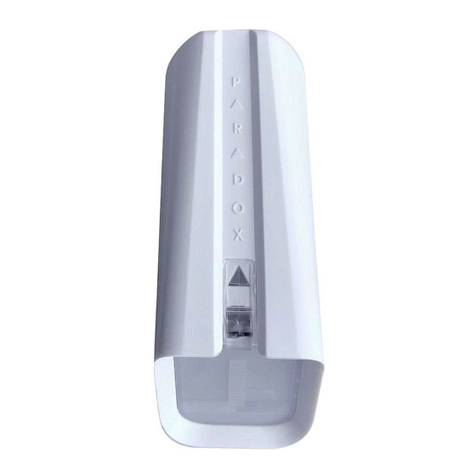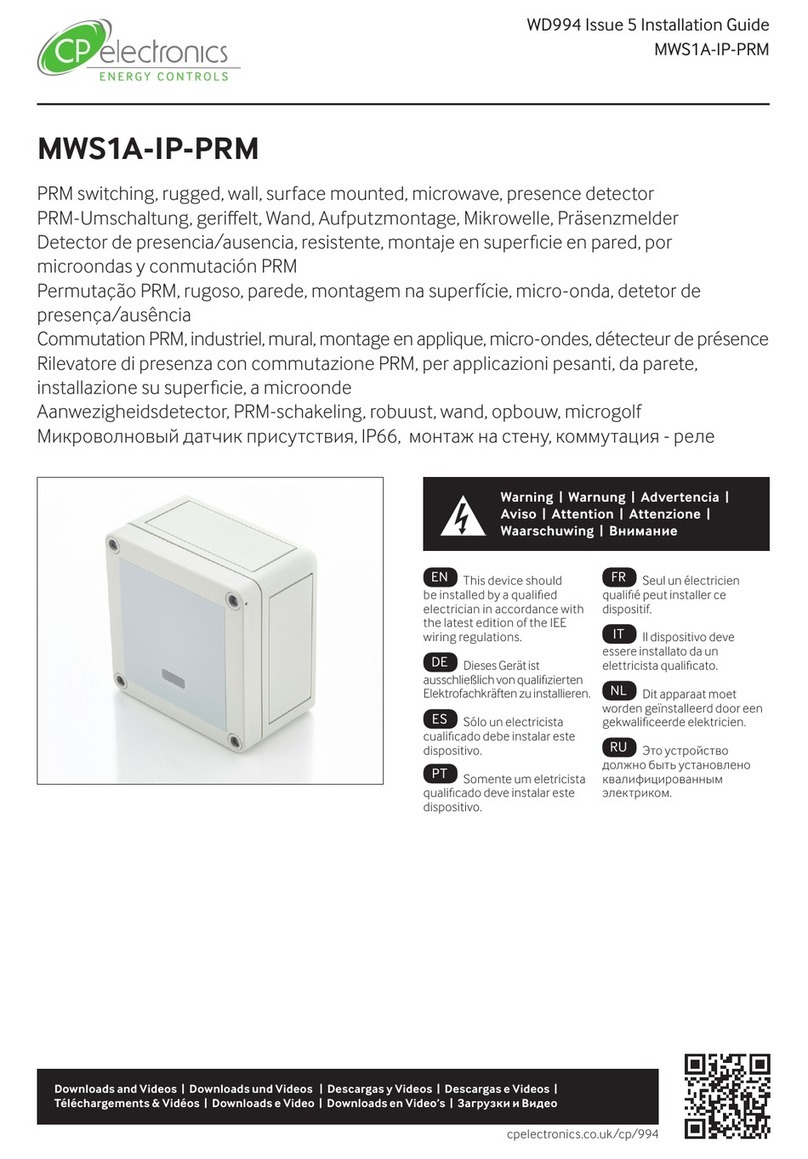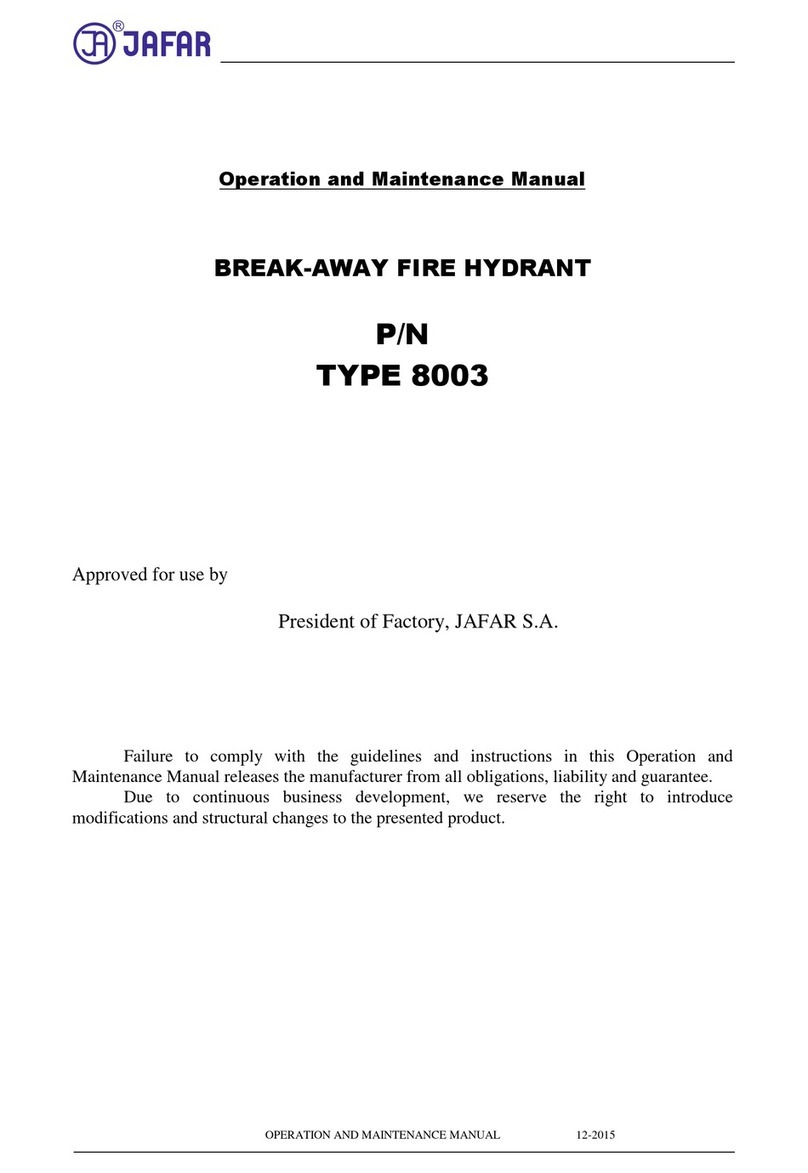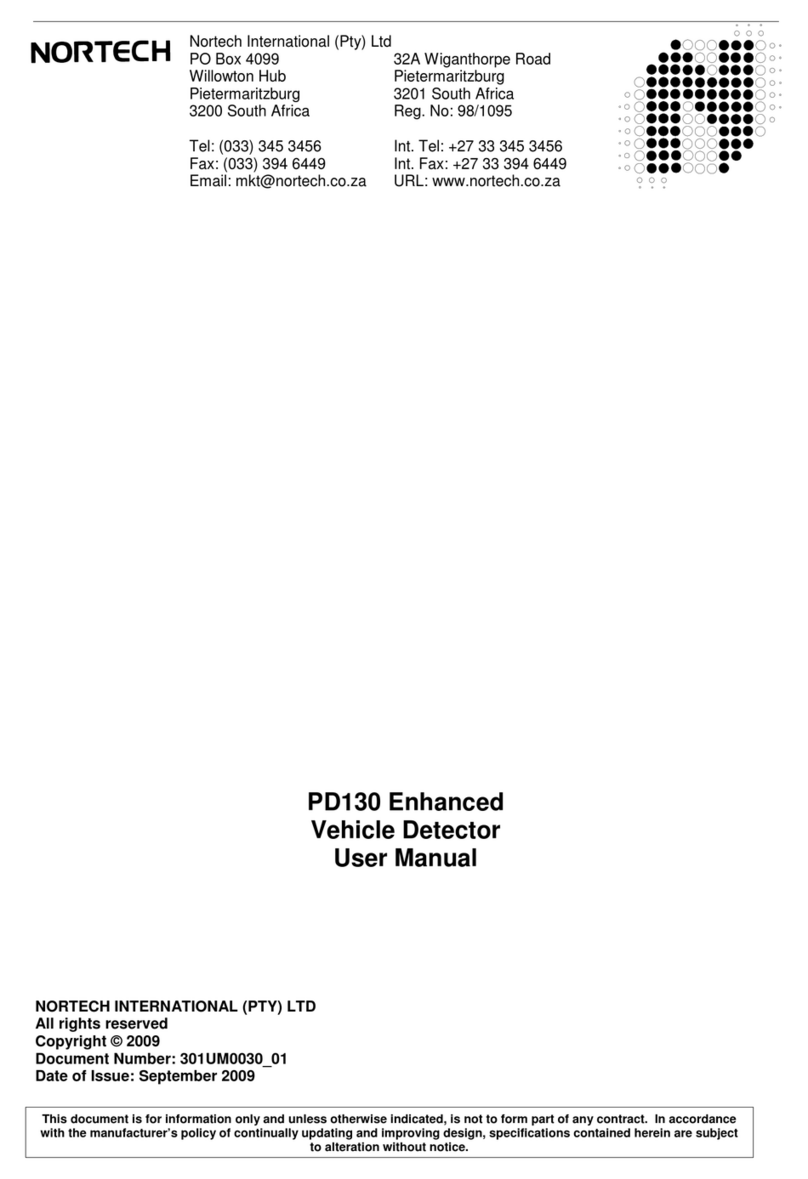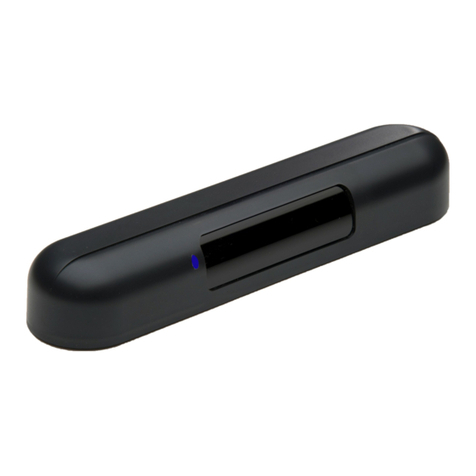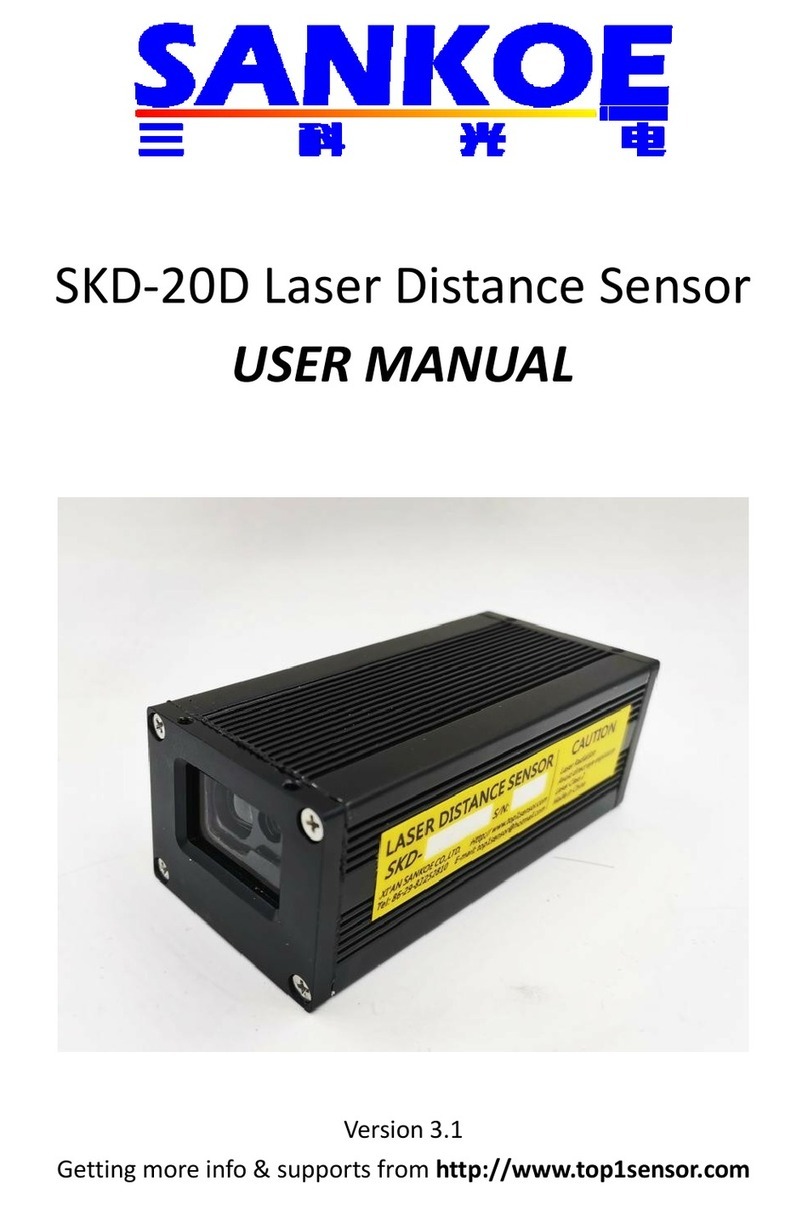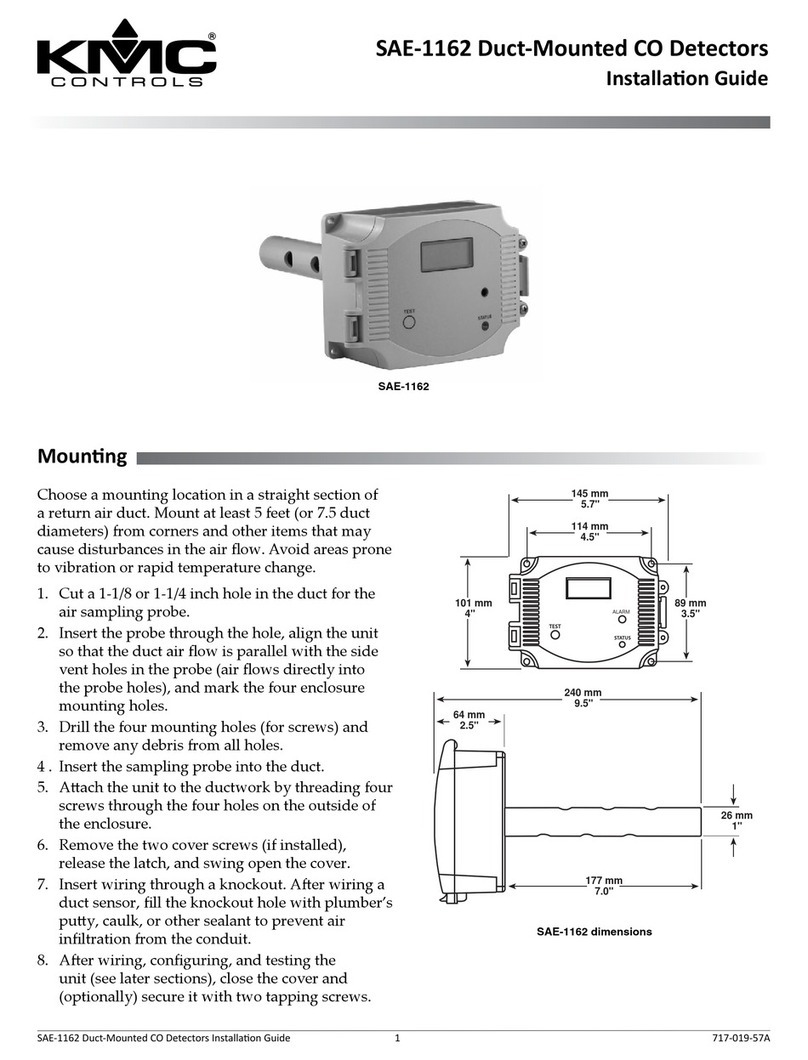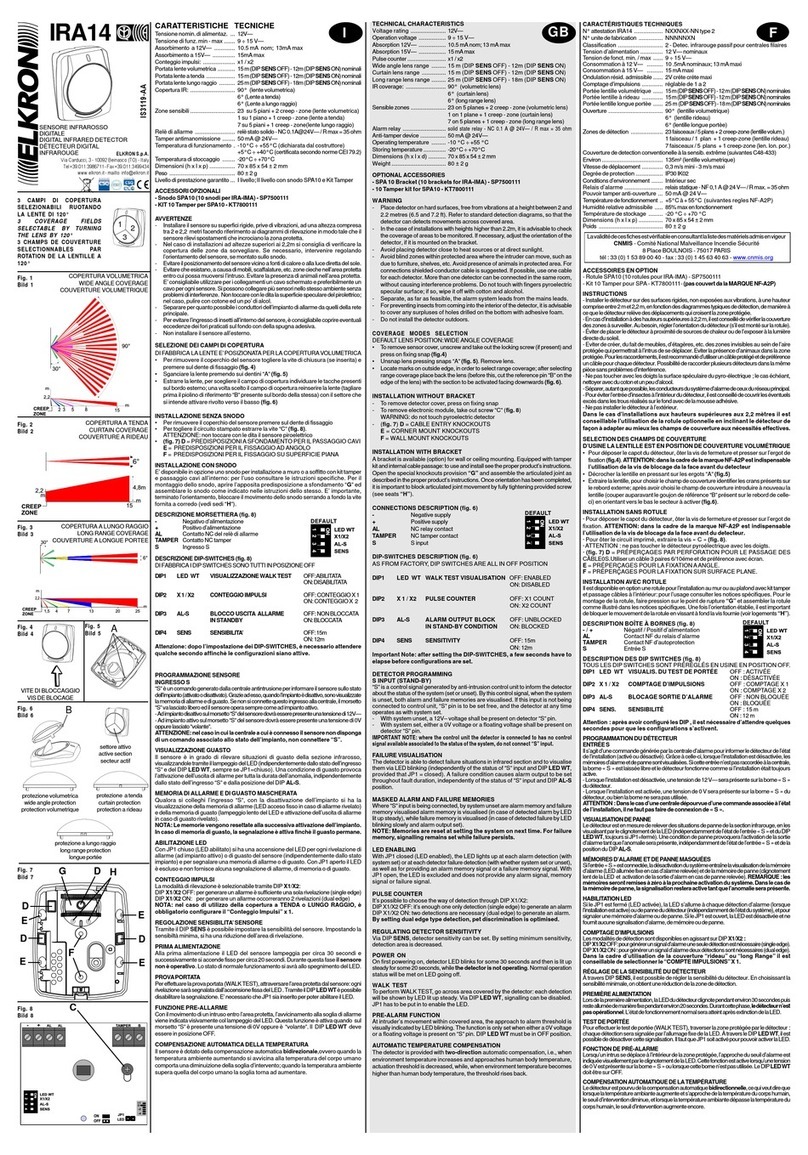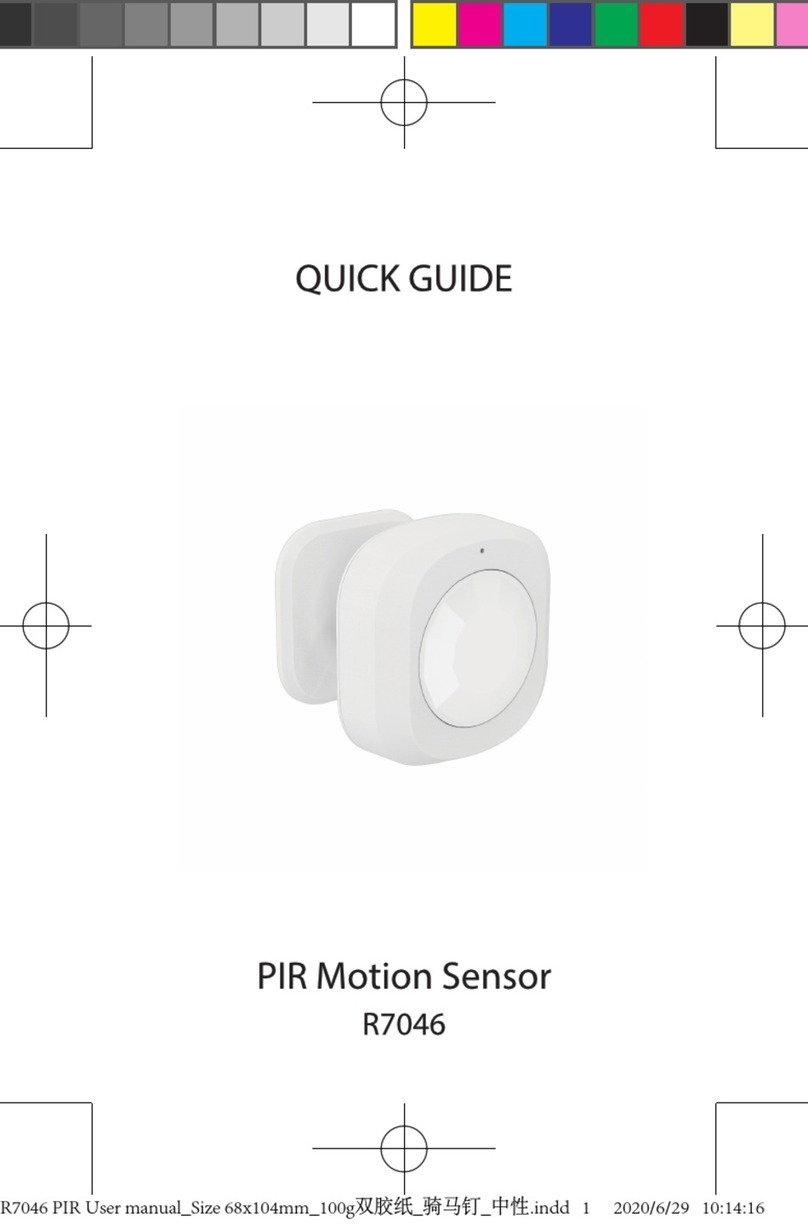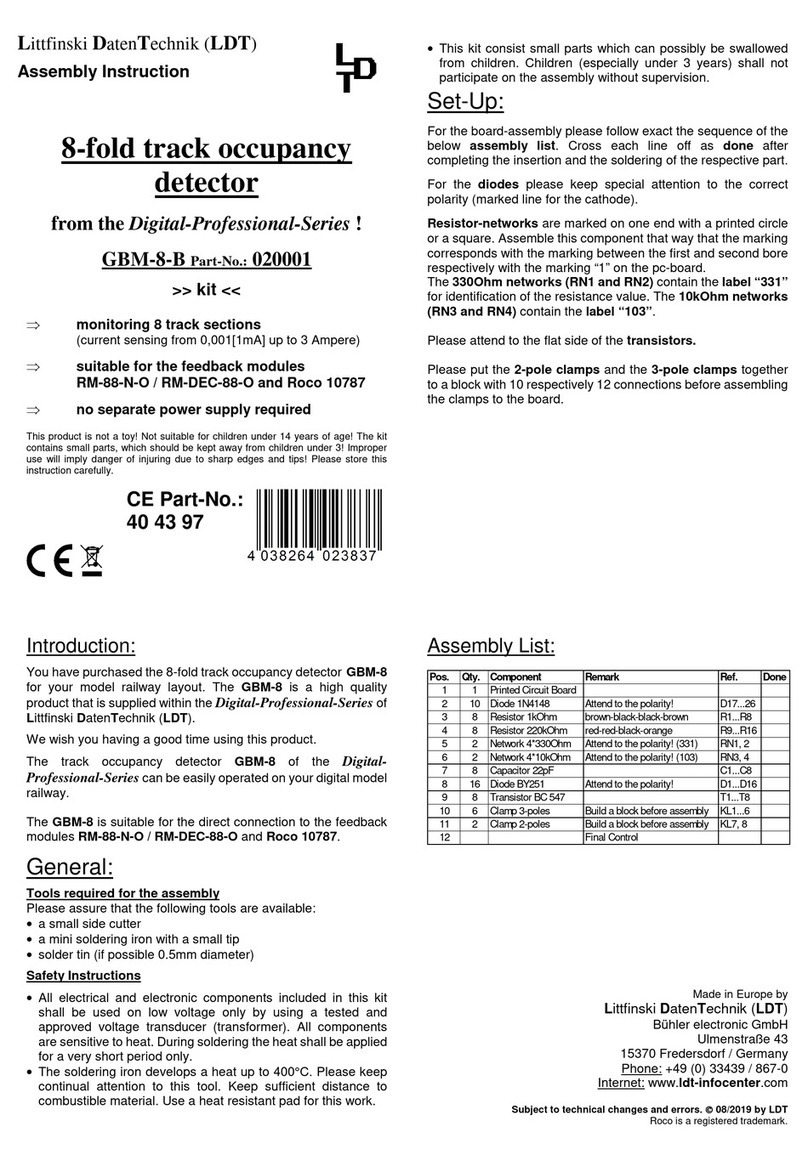Livox Tele-15 User manual

Livox Tele-15
v1.0
2020.03
User Manual

2
©2020 Livox Tech. All Rights Reserved.
Using this Manual
Legend
Warning Important Hints and Tips Explanation
Downloading Documents
Visit the link below to download the latest Livox Tele-15 User Manual and other documents related to
the Livox Tele-15.
www.livoxtech.com/Tele-15
Downloading Livox Viewer
Visit the link below to download Livox Viewer and Livox Viewer User Manual.
www.livoxtech.com/Tele-15
Downloading Livox SDK
Visit the link below to download the Livox SDK:
https://github.com/Livox-SDK
Searching for Keywords
Search for keywords such as “FOV” and “mount” to nd a topic. If you are using Adobe Acrobat Reader
to read this document, press Ctrl+F on Windows or Command+F on Mac to begin a search.
Navigating to a Topic
View a complete list of topics in the table of contents. Click on a topic to navigate to that section.
Printing this Document
This document supports high resolution printing.

©2020 Livox Tech. All Rights Reserved.
3
Contents
Using this Manual 2
Legend 2
Downloading Documents 2
Downloading Livox Viewer 2
Downloading Livox SDK 2
Product Prole 4
Introduction 4
Product Characteristics 4
Overview 6
Connectors 8
LiDAR Connector 8
Power Cable and Sync Cable 9
Ethernet Port 9
Mounting the Livox Tele-15 10
Effective Field of View (FOV) Range 10
Mounting Notice 10
Removing the Self-Dissipation Module 10
Dimensions 11
Getting Started 13
External Power Supply 13
Connection 14
Usage 16
Coordinates 16
Output Data 16
Working States & Working Modes 19
Dual Return Mode 20
IMU 20
Software Development Kit (SDK) 21
Storage, Transportation, and Maintenance 21
Storage 21
Transportation 21
Maintenance 21
Troubleshooting 22
After-Sales Information 22
Appendix 23
Appendix 1 23
Appendix 2 24
Appendix 3 25
Specications 25

4
©2020 Livox Tech. All Rights Reserved.
Product Prole
Introduction
Livox Tele-15 (hereinafter referred as “Tele-15”) features a long detection distance, high precision,
and high reliability, and can be used for multiple applications including autonomous driving, rail trac,
mapping, and security.
High FOV Coverage: The Tele-15 utilizes Livox’s unique non-repetitive scanning technology and
multi-laser and multi-APD DL-Pack technology. This ensures a high-density point cloud which is
approximately ve times denser than the Livox Mid-40 within the same period.
High Detection Range: Tele-15 has an extremely high signal-to-noise ratio due to its advanced
photoelectric design. With a luminance of 100 kilolux, the high sensitivity function can detect objects
with a 10% reectivity at up to 320 meters away.
High Reliability: The Tele-15 offers enhanced reliability as the cutting-edge design works normally
without rotating internal electronic devices such as the transmitter and receiver. The Tele-15 has
undergone rigorous reliability testing required by the automotive industry. In addition, the Tele-15 has
achieved an IP67 waterproof and dustproof rating under GB 4208-2008 and IEC 60529 standards.
Note the included cables do not meet the same standards.
Environmental Adaptation: The built-in tag information helps users identify the type and accuracy of
the low noise. Tele-15 avoids interference caused by strong environment light and lters most noise
caused by sunlight. When the environment temperature exceeds 65° C (149° F), the noise lter ability
decreases. Even with a luminance of 100 kilolux, the Tele-15 boasts a low noise rate lower than 0.01%.
Built-in IMU Module: The model of the build-in inertial measurement unit (IMU) is BMI088. The push
frequency of the IMU is 200 Hz.
User-friendly Livox Viewer: Livox Viewer is a Windows software specially designed for Livox LiDAR
sensors. It displays and records real-time point cloud data, replays point cloud videos, and analyzes the
3D point cloud data. Users can set product parameters and calibrate extrinsics using Livox Viewer. The
simple interface makes Livox Viewer easy to use.
Livox SDK: A software development kit (SDK) is provided to help develop customizable applications
using the data acquired from point cloud data. Livox SDK supports Windows/Linux/Mac OS/ROS.
• This distance can be reached when the target object reflects 50% or more of incident light (e.g.,
grey concrete walls and roads have a reflectivity range from 15% to 30%) in an environment with
a temperature of 25° C (77° F). The default maximum detection range is 500 meters. However,
with customized firmware, the maximum detection range can be increased to up to 1,000 meters.
Contact Livox at https://www.livoxtech.com/contact if you require detection beyond 500 meters.
• Before using for the first time, remove the screen protector from the optical window.
Product Characteristics
The Tele-15 utilizes Livox’s unique non-repetitive scanning technology and multi-laser and multi-APD DL-
Pack technology. This ensures a high-density point cloud which is approximately ve times denser than
the Livox Mid-40 within the same period. Over time, the coverage inside the FOV increases signicantly
and reveals more detailed information of the surroundings.
Figure 1.2.1 displays the point cloud data of the Tele-15 inside the FOV within 0.1s. In the center of
the FOV, the scanning density is as dense as traditional 300-line LiDAR sensors. In other areas of the
FOV, the scanning density is signicantly denser than 100-line LiDAR sensors. Within Tele-15’s FOV, the
overall scanning density rivals traditional 128-lines LiDAR sensors within 0.1s.

Livox Tele-15 User Manual
©2020 Livox Tech. All Rights Reserved.
5
According to the denition of the Livox coordinate system, the angle range is 0° to 360°, so -10° to 0° is
the same as 350° to 360°.
Figure 1.2.3 displays the FOV coverage of the Tele-15 compared with other non-Livox LiDAR sensors that
use common mechanical scanning methods. The diagram shows that when the integration time is 0.1
seconds, the FOV coverage of the Tele-15 is approximately 99%, higher than the 128-line LiDAR sensor.
Figure 1.2.3 The FOV coverage of the Tele-15 and non-Livox LiDAR sensors using common mechanical scanning
methods. The 16-line non-Livox LiDAR sensor has a vertical FOV of 30°, the 32-line non-Livox LiDAR sensor is 41°, the
64-line non-Livox LiDAR sensor is 27°, and the 128-line non-Livox LiDAR sensor has a vertical FOV of 40°.
The performance of the scanning method is defined by the FOV coverage, which is calculated as
the fraction of FOV illuminated by laser beams. The FOV coverage (C) can be calculated with the
following formula:
Refer to the official Livox website for more information about how the FOV coverage is calculated.
C= Total area in FOV
Total area illuminated by laser beams
×100%
0 0.10.05 0.15 0.250.2 0.3 0.35 0.4
0
20
40
60
80
100
FOV Coverage (%)
Integration time
(s)
Tele-15
128 Lines
64 Lines
32 Lines
16 Lines
-10 -5 0 5 10
Azimuth/ deg
80
85
90
95
100
Zenith/ deg
-10 -5 0 5 10
Azimuth/ deg
80
85
90
95
100
Zenith/ deg
Figure 1.2.1Point cloud patterns of the Tele-15
within 0.1s
Figure 1.2.2Point cloud patterns of the Tele-15
within 0.2s

Livox Tele-15 User Manual
6
©2020 Livox Tech. All Rights Reserved.
Laser Wavelength 905 nm
Laser Safety Class 1 (IEC 60825-1:2014) (Safe for eyes)
Detection Range (@100 klx) 320 m @ 10% reectivity, 500 m @ 50% reectivity
FOV 14.5° (Horizontal) × 16.2° (Vertical)
Range Precision (1σ) < 2 cm (5 to 70 m), < 4 cm (70 to 120 m) @ 10% reectivity
< 2 cm (5 to 220 m), < 4 cm (220 to 380 m) @ 80% reectivity
Angular Precision (1σ) < 0.03 º
Beam Divergence 0.02° (Horizontal) × 0.12° (Vertical)
Point Rate 240,000 points/s (rst or strongest return)
480,000 points/s (dual return)
False Alarm Ratio (@100 klx) < 0.01%
• Tested with a Lambertian target in an environment with a temperature of 25° C (77° F), under
100 kilolux conditions with high sensitivity function enabled. The actual environment may
differ from the testing environment. The figure listed is for reference only. The performance
may decrease in extreme environments such as those with foggy weather, that cause strong
vibration, or where the temperature is -40° C (-40° F) or 85° C (185° F).
• The built-in high sensitivity function increases the detection range of Tele-15, especially of
small objects with low reflectivity. The high sensitivity function is enabled by default and can be
disabled via Livox Viewer or SDK. When the environment temperature exceeds 65° C (149° F),
Tele-15 reduces the sensitivity to ensure measurement accuracy. Objects with a reflectivity of
50% can be detected at a range of up to 500 meters in an environment within a temperature
range of -40° to 85° C (-40° to 185° F).
• Vicinity Blind Zone: Objects that are within 2.5 meters cannot be measured precisely. When the
distance from an object is less than 0.3 meters, an occlusion warning is sent by error code. The
point cloud data may be distorted to a varying extent when the target object is within a range of
2.5 to 5 meters. Contact Livox for support if you require to detect objects within this range.
Overview
Livox Tele-15
Table 1.2.1 Point cloud specifications
1. M3 Mounting Holes
Make sure to use the correct screws when
mounting.
2. 1/4 Inch Mounting Hole
Can be mounted on a tripod or other bases
outtted with a 1/4 inch screw.
3. Locating Hole 1
4. Locating Hole 2
5. Self-Dissipation Module
The self-dissipation module is removable. If it
is removed, make sure that the temperature of
the LiDAR shell does not exceed 85° C (185°
10
7
8
9
2
2
4
3
1
4
3
5
6
1

Livox Tele-15 User Manual
©2020 Livox Tech. All Rights Reserved.
7
F). It is recommended to operate the Tele-15 in
an environment with a temperature lower than
65° C (149° F). An external thermal dissipation
system can also be designed. Otherwise, the
Tele-15 may enter the over temperature error
status and stop working. The self-dissipation
module is not designed to be mounted and
detached several times. Only remove the self-
dissipation module when necessary.
6. Optical Window
The laser passes through the optical window
and scans objects in the FOV.
7. Air Outlet
The air outlet allows warm air to exit the self-
dissipation module. Make sure there are at
least 10 millimeters between the air outlet and
the nearest objects.
8. Self-Dissipation Module Screws
Six black M2.5 screws are used to secure the
self-dissipation module. If the self-dissipation
module is detached, make sure to store the
screws properly for future use.
9. Air Inlet/Fan
The fan enables airflow to cool the LiDAR.
Make sure there are at least 10 millimeters
between the air inlet and the nearest objects.
10. LiDAR Connector
The LiDAR connector is used to connect the
Livox Converter 2.0. It also can be modified
by users. Refer to the Cables section for
information on signal definition. When the
Tele-15 is connected to the external power
source directly, make sure the output voltage
range of the external power source is within
the working voltage range of the Tele-15.
Livox Converter 2.0
1. LiDAR Connector Port
A JAE MX34012NF1 type connector port used
to connect to the Tele-15. The mating connector
is JAE MX34012SF1 LiDAR.
2. Power Port
Connects to an external power supply. When
the Tele-15 is connected to Livox Convertor
2.0, users can use a power supply of 9 to 30 V.
The connector type is MOLEX 1053313-1102.
The mating connector is MOLEX 105307-1202.
3. Ethernet Port
An RJ45 type Ethernet connector is used to
connect to Ethernet cables.
4. Sync Port
The 3-pin sync port supports 3.3V LVTTL sync
signal input. Refer to Table 2.2.2 for more
information. The mating connector of the sync
port connector is Famfull 9.510A0-003-1R0,
and JST GHR-03V-S is also compatible.
1
2 3 4

8
©2020 Livox Tech. All Rights Reserved.
Connectors
LiDAR Connector
Below is more information on the LiDAR connector:
Figure 2.1.1LiDAR Cable Connector
Pin Signal Type Description Color
1Power+ Power DC 10-15 V (max 15 V) Blue/white
2 Ground Power Ground Silver bare wire
3 Ethernet_TX+ Output 100BASE-TX, TX+ Orange/white
4 Ethernet_TX- Output 100BASE-TX, TX- Orange
5Ground Power Ground Silver braided wire
6Sync+ Input RS485_A, Pulse Per Second Grey/white
7 Power+ Power DC 10-15 V (max 15 V) Blue
8 Ground Power Ground Silver bare wire
9 Ethernet_RX+ Input 100BASE-TX, RX+ Green/white
10 Ethernet_RX- Input 100BASE-TX, RX- Green
11 Ground Power Ground Silver braided wire
12 Sync- Input RS485_B, Pulse Per Second Grey
Table 2.1.1LiDAR Cable Connector Description
Sync signal description
Figure 2.1.2Sync signal description
*Refer to the Software Development Kit (SDK) section for more information about the sync signal.
Pulse Per Second
(PPS)
t0
t1
t0=1s
1ms<t1<300ms
㘶۟
(PPS)
t0
t1
t0=1000 ms
20 ms < t1< 200 ms
121110987
4321 5 6 2
8
5/11
1
7
3
4
6
12
9
10

Livox Tele-15 User Manual
©2020 Livox Tech. All Rights Reserved.
9
Power Cable and Sync Cable
The Tele-15 cables package includes two power cables and two sync cables.
Power Cable
Connect “A” to the power port of the Livox Converter 2.0 and connect “B” to an external DC power
supply. The connector type of this power cable is MOLEX 105307-1202.
Figure 2.2.1Power cable
2
1
A B
500±25 mm
Pin Signal Type Description Color
1Power+ Power DC 9 - 30 V (max 30 V) Red
2 Ground Power Ground Black
Table 2.2.1Power cable description
Pin Signal Type Description Color
1Ground Power Ground Black
2Sync+ Input 3.3 V LVTTL, Pulse Per Second Blue
3 Reserved Reserved Undened White
Table 2.2.2Sync cable description
Sync cable
Connect “A” into the sync port of the Livox Converter 2.0 and connect “B” to the sync signal. The sync
cable has a 3-pin connector. The connector type is Famfull 9.510A0-003-1R0, which is compatible
with JST GHR-03V-S type connectors. Refer to the Data Synchronization section for more information.
Figure 2.2.2Sync cable
1AB
2
3
500±25 mm
Ethernet Port
The Livox Converter 2.0 supports 100BASE-TX standard RJ45 Ethernet port. The Tele-15 uses two
twisted pairs to send and receive data.

10
©2020 Livox Tech. All Rights Reserved.
Mounting the Livox Tele-15
Effective Field of View (FOV) Range
As shown below, the Tele-15 has a horizontal FOV of 14.5° and a vertical FOV of 16.2°. When mounting
a Livox LiDAR sensor, make sure that the FOV is not blocked by any objects. Visit www.livoxtech.com/
Tele-15 to download the 3D models of the Tele-15 and its FOV.
Figure 3.1.1Effective FOV of the Tele-15
Mounting Notice
Read and understand the following warnings before mounting the Tele-15.
1. Before use, remove the screen protector from the optical window.
2. Signicant dust and stains on the optical window will aect the performance of the Tele-15 LiDAR
sensor. Follow the instructions in the Maintenance section to clean the optical window using
compressed air, isopropyl alcohol, or a lens cloth.
3. When mounting the Tele-15, the eld of view must not be blocked by an object, including glass.
4. When mounting the Tele-15, make sure there is enough space for ventilation for the air inlet and air
outlet. Allow at least 10 millimeters from the nearest objects.
5. There are no restrictions on which direction the Tele-15 can be installed. The top or bottom surface
can be used to mount the Tele-15. It is recommended that the surface is parallel to the ground when
mounting.
6. The Tele-15 cannot bear any extra payload. Otherwise, the reliability of the product cannot be
guaranteed.
7. The 1/4 inch mounting hole is only recommended for use with the tripod and other platforms in
situations where the surface is static.
Removing the Self-Dissipation Module
Located on the top of the Livox Tele-15 is the self-dissipation module. Users are able to detach the
self-dissipation module. However, make sure to prepare an alternative dissipation system so that the
Livox Tele-15 can work properly without the self-dissipation module. Otherwise, the highest working
temperature of Livox Tele-15 may be decreased when the self-dissipation module is detached. The
self-dissipation module is not designed to be mounted and detached repeatedly. Only remove the self-
dissipation module if necessary.
Horizontal FOVVertical FOV
42.0mm
16.2° 14.5°

Livox Tele-15 User Manual
©2020 Livox Tech. All Rights Reserved.
11
Figure 3.3.1Removing the Self-Dissipation Module
To remove the self-dissipation module, remove the six M2.5 screws using the provided hex screwdriver
and then detach the module. If you need to re-install the self-dissipation module, make sure the
connectors on the top of the Livox Tele-15 and the self-dissipation module are aligned, and secure the
self-dissipation module using six black M2.5 screws.
When the self-dissipation module is detached, make sure to attach the provided rubber seal to the fan
connector on the top of the Livox Tele-15. Make sure that the temperature of the LiDAR shell does not
exceed 85° C (185° F). It is recommended to operate the Tele-15 in an environment with a temperature
lower than 65° C (149° F). An external thermal dissipation system can also be designed.
Dimensions
Livox Tele-15 (with the self-dissipation module)
Refer to the dimensions and the mounting holes in the diagram below to mount or embed the Livox
Tele-15 to or in an appropriate place on the target base. When the self-dissipation module is attached
to the Livox Tele-15, the Livox Tele-15 can be mounted on the target base using M3 screws or outtted
with ¼ inch mounting holes.
45.045.0
106.5
16.0
122.0
38.0
8.05
3.05±0.03
94.2
112.0
42.0
11.8
28.0
16.0
45.045.0
3.05±0.03
8.59
106.5
6-M3 THRU
8.05
3.05±0.03
1/4-20 UNC 5
4.09±0.06
12.06
6-M3 7.5
1/4-20 UNC 7
3.05±0.03 3

Livox Tele-15 User Manual
12
©2020 Livox Tech. All Rights Reserved.
Unit: mm
Unit: mm
Figure 3.4.2The Tele-15 Dimensions without Self-Dissipation Module
(refer to Appendix 2)
Weight Approx. 1600 g (includes a cable with an approx. length and weight of 1.5 m and 150 g)
Dimensions 112 × 94.2 × 122 mm
Table 3.4.1The Tele-15 Weight & Dimensions (with self-dissipation module)
Table 3.4.2The Tele-15 Weight & Dimensions (without self-dissipation module)
Weigh (with cable) Approx. 1500 g
Dimensions 112 × 82.4 × 122 mm
Figure 3.4.1The Tele-15 Dimensions with Self-Dissipation Module
(refer to Appendix 1)
Livox Tele-15 (without the self-dissipation module)
Refer to the dimensions and the mounting holes in the diagram below to mount or embed the Livox
Tele-15 to or in an appropriate place on the target base.
45.045.0
106.5
16.0
122.0
38.0
8.05
3.05±0.03
94.2
112.0
42.0
11.8
28.0
16.0
45.045.0
3.05±0.03
8.59
106.5
6-M3 THRU
8.05
3.05±0.03
1/4-20 UNC 5
4.09±0.06
12.06
6-M3 7.5
1/4-20 UNC 7
3.05±0.03 3
(55.0- 60.0)
Cable Bending Radius
(55.0- 60.0)
Cable Bending Radius
6-M3 THRU
82.4
112.0
42.0
12.06
45.045.016.0
106.5
3.52
2.52±0.02 3
2.52±0.02 3
16.0
45.045.0
3.05±0.03
8.59
106.5
6-M3 THRU
8.05
3.05±0.03
1/4-20 UNC 5
4.09±0.06
122.0

Livox Tele-15 User Manual
©2020 Livox Tech. All Rights Reserved.
13
Weight Approx. 88 g
Dimensions 74 × 52 × 23 mm
Table 3.4.3Livox Converter 2.0Weight & Dimensions
Livox Converter 2.0
Refer to the dimensions below to mount the Livox Converter 2.0.
74
52 22.9 37
66
4-M2 2.5
Figure 3.4.3Livox Converter 2.0Dimensions
(refer to Appendix 3)
Unit: mm
Getting Started
External Power Supply
The working voltage range of the Tele-15 is from 10 to 15 V. When an extension cable is required, make
sure to increase the output voltage of the external power source due to the extra voltage reduction.
Make sure the maximum voltage does not exceed 15 V. The minimum working voltage should be
increased in a low temperature environment. Note that the power cable may generate voltage uctuation
where the voltage exceeds 15 V in some scenarios such as if the power cable is interfered with or other
devices connected to another power source in the parallel circuit suddenly power o. In such situations,
the Tele-15 may not work normally or may even become damaged.
In an environment where the temperature is 25° C, the working power of the Tele-15 is 12 W. The
working power of the Tele-15 varies at dierent temperature. Below shows the relationship between the
temperature of the environment and the working power of the Tele-15.
Figure 4.1.1The working power of the Tele-15 at varying temperatures
-30 10-40 5020 40 60
13w
12w
70300-10
45
0
5
10
15
20
25
30
35
40
-20 80 85
Temperature (° C)
Power (W)
Without self-dissipation module
With self-dissipation module
-40 20 40 600
45
0
5
10
15
20
25
30
35
40
温度 (°C)
功率 (W)
-20 80 85
启动功耗
运行功耗
Power (W)
Temperature (° C)
Startup PowerStartup Power
Operating PowerOperating Power

Livox Tele-15 User Manual
14
©2020 Livox Tech. All Rights Reserved.
Figure 4.2.1Connecting using static IP address
Connection
The Tele-15 uses a compact and reliable electrical connector for power supply as well as control signal
and data transmission. Refer to the Cables section for more information about the connector. The Livox
Converter 2.0 integrates a LiDAR port, a sync port, a power port, and an Ethernet port. To ensure
optimal performance, it is recommended to always use a Livox Converter 2.0.
The Tele-15 supports two IP modes: dynamic IP address mode and static IP address mode. All Tele-
15 LiDAR sensors are set to static IP address mode by default with an IP address of 192.168.1.1XX
(XX stands for the last two digits of the Livox Tele-15 LiDAR sensor’s serial number). The default
subnet masks of the Livox Tele-15 LiDAR sensors are all 255.255.255.0, and their default gateways
are 192.168.1.1. Directly connect the Livox Tele-15 to the computer before using for the rst time. The
static and dynamic IP addresses are connected in dierent ways. 1.The static IP address is connected
by default and in this mode, the Tele-15 can be connected to a computer directly. Any static IP address
can be set for the Tele-15 through Livox Viewer or SDK. 2. To connect to the dynamic IP address, make
sure the Tele-15 is switched to dynamic IP mode by using the Livox Viewer or SDK. In dynamic address
mode, the addresses are assigned to the Tele-15 using dynamic host conguration protocol (DHCP).
Static IP address :
1. Follow the steps to set the IP address of your computer to static IP address:
Windows system
a. Click to enter in the Network and Sharing Center under Control Panel.
b. Click the network you are using, and click “Properties”.
c. Double click “Internet Protocol Version 4 (TCP/IPv4)”.
d. Set the static IP address of the computer to 192.168.1.50 and the subnet mask to
255.255.255.0. Click “OK” to complete.
Ubuntu-16.04 system
The IP address of the computer can be congured by using the ifcong command at the terminal.
The conguration code is as below:
~$ sudo ifconfig enp4s0 192.168.1.50 (replace “enp4s0” with the network port name of the
computer)
2. Connect the Tele-15, Livox Converter 2.0, external power source, and computer by following Figure 4.2.1.
Livox Converter
Livox Tele-15
External Power
Suppply
Ethernet Cable

Livox Tele-15 User Manual
©2020 Livox Tech. All Rights Reserved.
15
Dynamic IP address:
1. Follow Figure 4.2.1 to connect the Tele-15, Livox Converter 2.0, external power source, and
computer.
2. Run Livox Viewer, click to open the settings page, and set the IP address of the Tele-15 to
dynamic IP address.
3. Disconnect the Tele-15, Livox Converter 2.0, external power source, and computer.
4. Follow the steps to set the IP address of your computer to dynamic IP address:
Windows system
a. Click to enter the Network and Sharing Center under Control Panel.
b. Click the network you are using, and click “Properties”.
c. Double click “Internet Protocol Version 4 (TCP/IPv4)”.
e. Select “Obtain an IP address automatically” and “Obtain DNS server address automatically”, then
click “OK” to complete.
Ubuntu-16.04 system
a. Click to open “Network”.
b. Click “IPv4”, and then click “Automatic (DHCP)”. Click “Apply” to complete.
5. Connect the Tele-15, Livox Converter 2.0, router, computer, and external power supply by following
Figure 4.2.2.
• If multiple Tele-15 LiDAR sensors are set to static IP addresses, make sure all the Tele-15 LiDAR
sensors have different IP addresses and use a switchboard to connect them to the computer.
• Launch Livox Viewer after the Tele-15 is connected. Click the device that the static IP address
should be altered. Click to open the settings page and set the static IP address of the Tele-15.
• If more than six Tele-15 LiDAR sensors are required, use a kilo mega switchboard. Otherwise, data may
get lost and there may be connection failures.
a. Connect the Tele-15 to the Livox Converter 2.0.
b. Connect the Livox Converter 2.0 to your computer using an Ethernet cable.
c. Connect the Livox Converter 2.0 to an external power source.
Figure 4.2.2Connecting using dynamic IP address
Livox Tele-15
External Power
Suppply
Router with DHCP
Ethernet Cable

Livox Tele-15 User Manual
16
©2020 Livox Tech. All Rights Reserved.
• If more than six Tele-15 LiDAR sensors are required, use a kilo mega router.
• The broadcast number for each LiDAR sensor can be viewed in the Device Manager of Livox
Viewer or the SDK. For the Tele-15, the broadcast number will be its serial number ending in an
additional “1”.
a. Connect the Tele-15 to the Livox Converter 2.0.
b. Connect the computer and the Livox Converter 2.0 to the router using Ethernet cables. Make sure
both the Livox Converter 2.0 and the computer are connected to the LAN port on the router.
c. Connect the Livox Converter 2.0 to an external power source.
Usage
Coordinates
The Tele-15 has a built-in IMU. The coordinates of the point cloud O-XYZ and of the IMU O'-X'Y'Z' are
dened as below:
Figure 5.1.1Coordinates of the Tele-15
Output Data
The output information of Livox Tele-15 LiDAR sensors includes point cloud data and IMU data. Both
point cloud data and IMU data have timestamp and status codes, while point cloud data also has the
target reectivity, coordinates, and tag information.
Point Cloud Data
A point cloud is the collection of the points where the surface of an object was detected in
the FOV of the LiDAR sensor. Each point contains the following information.
Target reflectivity: 0 to 255. 0 to 150 corresponds to the reflectivity within the range of 0 to
100% in the Lambertian reflection model. 151 to 255 corresponds to the reflectivity of target
objects with retroflection properties.
The origin O' of IMU coordinates is defined in the point cloud coordinates as -84.7, -42.5, -35.3
(Unit: mm).
42.0mm
Z
Y
XX
Z
XY
Z
M
P(r,θ,φ)
o
θ
φ
Y
14.5°
16.2°
o
X
Z
YX' Y'
Z'
o'

Livox Tele-15 User Manual
©2020 Livox Tech. All Rights Reserved.
17
Figure 5.2.1.1 Relationship between Cartesian
coordinates and Spherical coordinates
x= r×sin(θ)×cos(φ)
y = r×sin(θ)×sin(φ)
z = r×cos(θ)
Tags: Indicates the return type of the laser and if the point detected is a noise. The format of the tag is
as shown below:
bit7 bit6 bit5 bit4 bit3 bit2 bit1 bit0
Reserved Return number:
00:return 0
01:return 1
10:return 2
11:return 3
Point property based on intensity:
00:Normal
01:High condence level of the noise
10:Moderate condence level of the
noise
11:Reserved
Point property based on spatial
position:
00:Normal
01:High confidence level of the
noise
10:Moderate confidence level of
the noise
11:Low confidence level of the
noise
Coordinates: Can be expressed as Cartesian coordinates (x, y, z) and Spherical coordinates
(r, θ, φ). The relationship between Cartesian and Spherical coordinates is shown in the figure
below. When there is no object within the detective range or the object is placed outside the
detective range, the coordinates of the point cloud will be expressed as 0, 0, 0 in Cartesian
coordinates and as 0, θ, φ in Spherical coordinates.
Each tag is composed of one byte. In this byte, bit7 and bit6 are Group 1, bit5 and bit4 are Group 2,
bit3 and bit2 are Group 3 while bit1 and bit0 are Group 4.
Group 2 indicates the return sequence of the sampling point. Featuring a coaxial optical path, the Tele-
15 itself will generate a laser return even if there is no detectable object around. This return is recorded
as return 0. After that, if there is any object within the detectable range, the rst laser that returns to the
Tele-15 is recorded as return 1, and then return 2, and so on. If the object is too close to the Tele-15,
such as 1.5 m away, the rst eective return will be merged into return 0, and be recorded as return 0.
Group 3 indicates if the sampling point is a noise based on the intensity of the return. Normally, the
intensity of the returns of the noises generated due to the interference of atmosphere particles such as
dust, rain, fog, and snow is quite low. Therefore, the noises are divided into two categories based on
the intensity of the return received. "01" stands for low intensity of the return, indicating that the samples
42.0mm
Z
Y
XX
Z
XY
Z
M
P(r,θ,φ)
o
θ
φ
Y
14.5°
16.2°
o
X
Z
YX' Y'
Z'
o'

Livox Tele-15 User Manual
18
©2020 Livox Tech. All Rights Reserved.
Figure 5.2.2.1Pulse Per Second
Figure 5.2.2.2UTC Time Commands
GPS: The GPS module outputs and transmits PPS signal and UTC time to the Tele-15 to synchronize
the data. The PPS signal is sent to the Tele-15 via the sync cable and the UTC time is sent to the Tele-
15 via SDK. Refer to the SDK Communication Protocols section for more information about commands.
The logic of the UTC Time and PPS signal command are shown below. The timestamp of the point
cloud data stands for the UTC sampling time of the point cloud once GPS synchronization is in use.
PPS
UTC
1
0
t0
t1
t4
t0: 1000 ms
t1: 20 ms ≤ t1 ≤ 200 ms
t4: 10 ms ≤ t4 ≤ 500 ms
have a high possibility of being noises such as dust. "10" stands for moderate intensity of the return,
indicating that the samples have a moderate possibility of being noises such as rain and fog. The lower
the condence level of the sample is, the lower the possibility that it is a noise.
Group 4 indicates if the sampling point is a noise based on its spatial position. Normally, when the Tele-
15 LiDAR sensors detect two close objects, there will be some thread-like noises between the two
objects. The noises are divided into three categories. The lower the condence level of the noise is, the
lower the possibility that it being a noise is.
Timestamp
Both point cloud data and IMU data have timestamp information. There are three ways to synchronize
data with the Tele-15: IEEE 1588-2008, Pulse Per Second (PPS), and GPS. When the three ways are
used simultaneously, the synchronization priority is IEEE 1588-2008 > GPS > PPS.
IEEE 1588-2008: IEEE 1588-2008 is the Precision Time Protocol (PTP) enabling precise synchronization
of clocks in measurement by Ethernet. Livox LiDAR sensors support UDP/IPV4 two-step PTP as well as
the following messages: Sync, Follow_up, Delay_req, and Delay_resp.
PPS: PPS uses the sync cable for data synchronization. Refer to the Cables section for more
information. The synchronization logic is shown in the gure below. The pulse interval in PPS is 1s (t0
= 1000 ms) while the continuous time of high-level voltage is from 20 ms to 200 ms. The rising edge
of PPS resets the timestamp to zero, so the timestamp of the point cloud data indicates the duration
between the point cloud sampling and the PPS rising edge.
Pulse Per Second
(PPS)
t0
t1
t0=1s
1ms<t1<300ms
㘶۟
(PPS)
t0
t1
t0=1000 ms
20 ms < t1< 200 ms

Livox Tele-15 User Manual
©2020 Livox Tech. All Rights Reserved.
19
Status Description
Temperature status Indicates if there is any temperature abnormality. Temperature status includes
normal, warning, and error.
Voltage status Indicates if there is any internal voltage abnormality. Voltage status includes
normal, warning, and error.
Motor status Indicates if there is any internal motor abnormality. Motor status includes
normal, warning, and error.
Dust warning Indicates if a signicant amount of dust is detected on the optical window, if
the optical window is covered by objects, or if there is an object less than 0.3
meters away from the LiDAR sensor.
Service life warning Indicates if the LiDAR sensor is nearing the end of its service life. The LiDAR
sensor can still work for a short period once this warning appears. It is
recommended to replace the LiDAR sensor once this warning appears.
PPS signal status Indicates whether the PPS sync signal is working normally.
Status Codes
Both point cloud data and IMU data have status codes information. The status codes display the
current working status of the Tele-15 LiDAR sensors. By checking the status codes, users can see the
temperature status, voltage status, motor status, dust warning, service life warning, and PPS signal
status. Status codes can be viewed in Livox Viewer or in the SDK. Refer to the Livox Viewer User
Manual for more information about how to check status codes.
Working states Description
Initializing The LiDAR sensor is powering on.
Normal The LiDAR sensor is powered on and working normally.
Standby The LiDAR sensor is powered on, but the laser beams are not active.
Power saving All components are powered o apart from the communication module.
Error The LiDAR sensor will enter error status when an error is detected and all the
components are powered o apart from the communication module.
Working States & Working Modes
The working states of the Livox Tele-15 includes initializing, normal, standby, power saving, and error.

Livox Tele-15 User Manual
20
©2020 Livox Tech. All Rights Reserved.
The Tele-15 also has three working modes: Normal, Standby, and Power Saving. These modes can be
set in Livox Viewer and SDK.
Dual Return Mode
The Tele-15 can be set to Dual Return mode using Livox Viewer or SDK. The Tele-15 can generate a
point cloud of up to two returns in Dual Return mode, which has a point rate of 480,000 points per
second.
To set the return mode, run Livox Viewer after the Tele-15 is connected. Click the desired device under
the device manager page. Click to select the return mode.
IMU
Tele-15 has a built-in IMU providing the altitude data of the Tele-15.
The push frequency of the IMU can be set using Livox Viewer or SDK. Setting the IMU push frequency
is the same as setting the return mode of the LiDAR sensor.
Figure 5.3.2Relationship between the different working modes available in Livox Viewer
Power
saving
Standby
Normal
Figure 5.3.1Relationship between the different working states
Power
saving
Initializing
Error
Standby
Normal
Other manuals for Tele-15
1
Table of contents
Popular Security Sensor manuals by other brands

PCB Piezotronics
PCB Piezotronics M354C03 Installation and operating manual
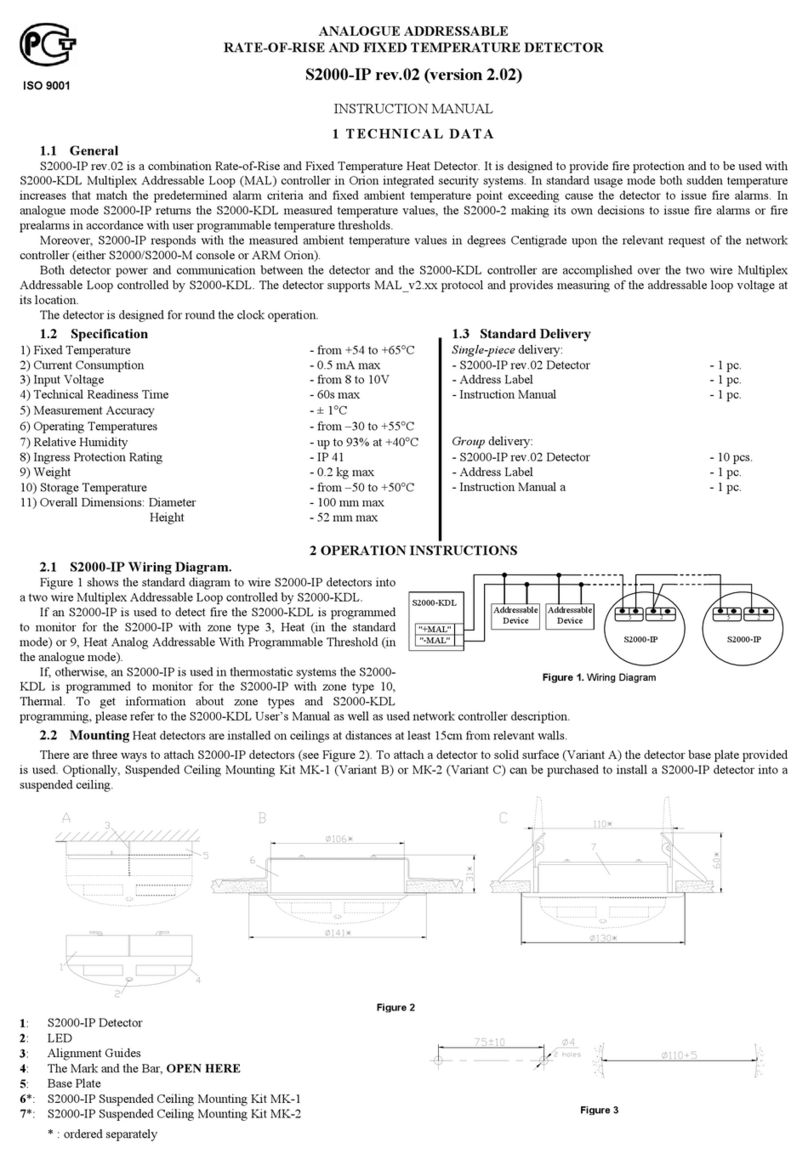
Bolid Security Systems
Bolid Security Systems S2000-IP instruction manual
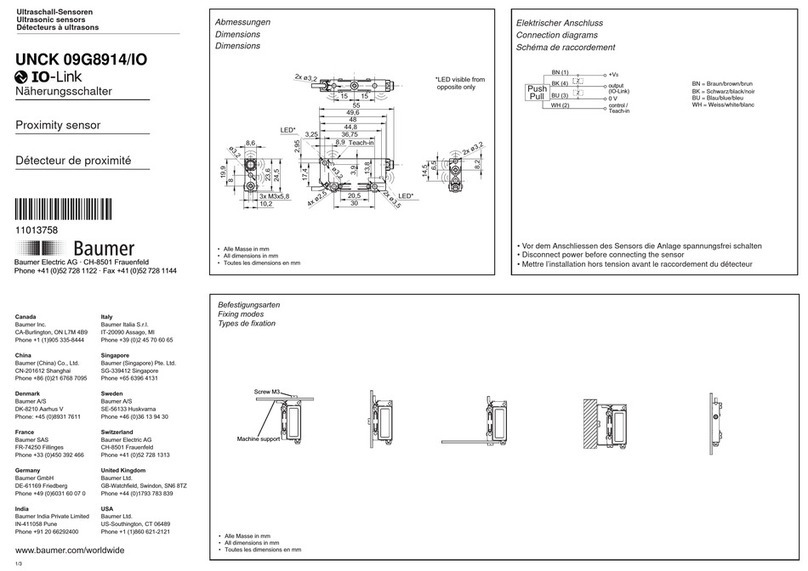
Baumer
Baumer UNCK 09G8914/IO quick start guide

ORBILOC
ORBILOC OUTDOOR DUAL user guide
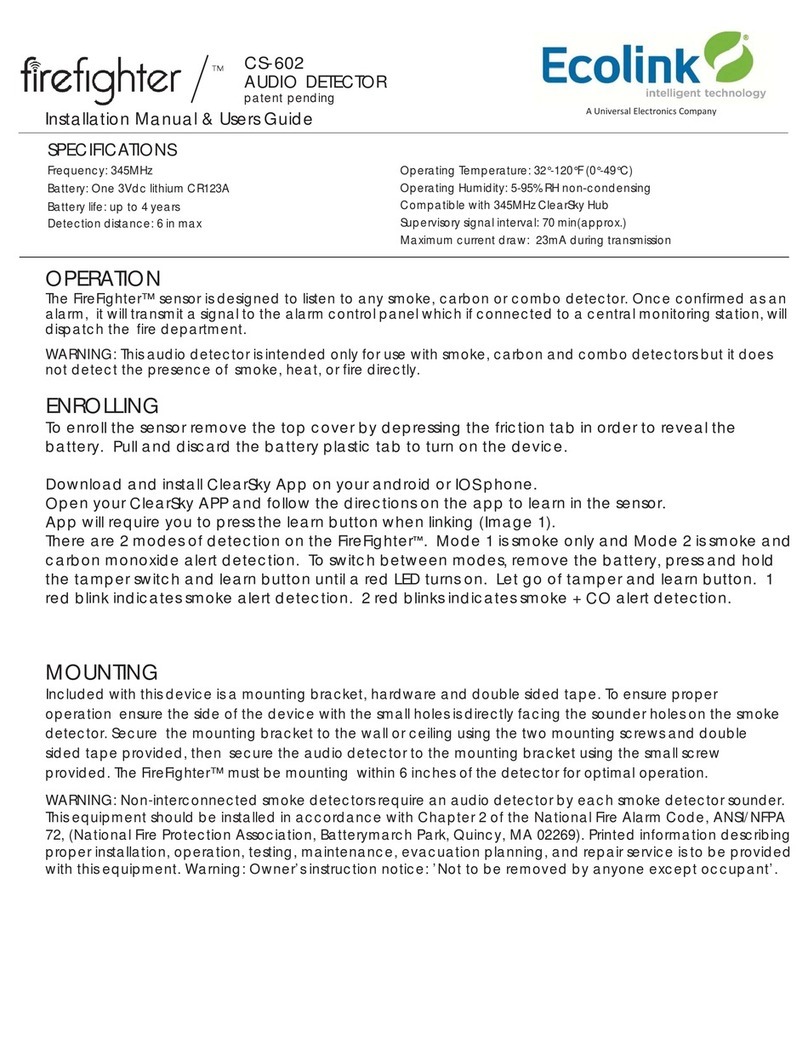
Ecolink
Ecolink FireFighter CS-602 Installation manual & users guide
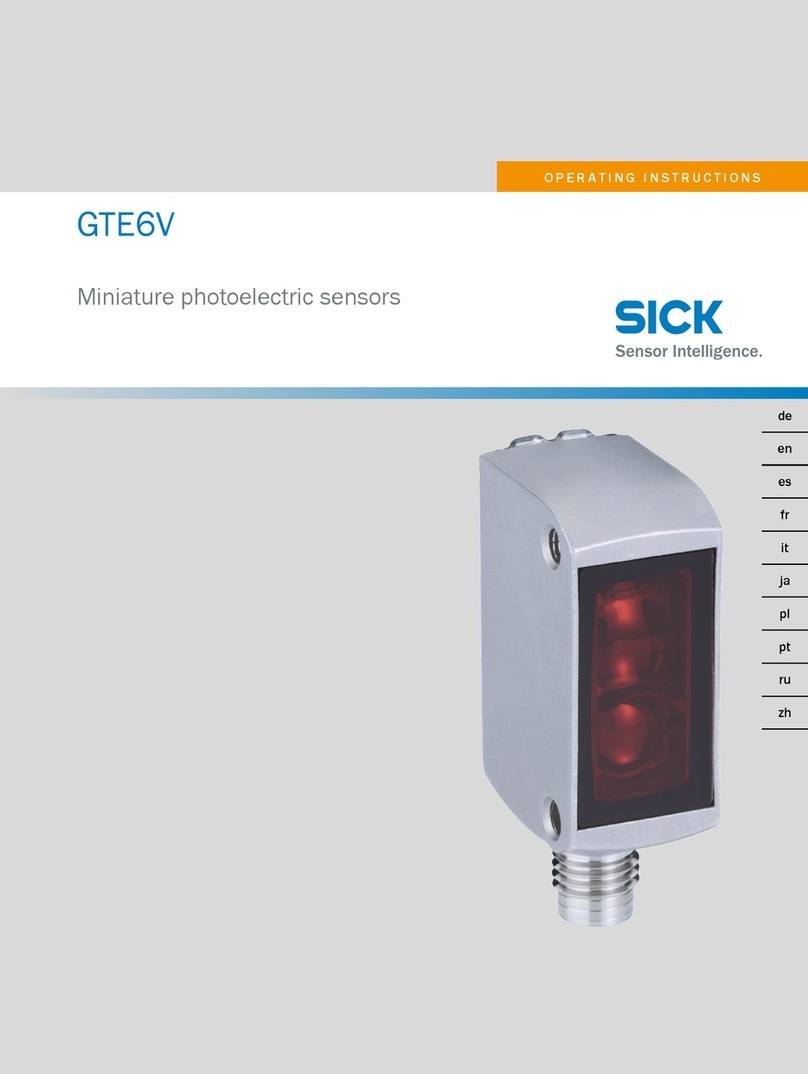
SICK
SICK GTE6V operating instructions
